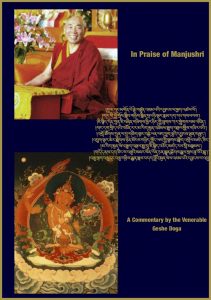| In Praise of Manjushri is a teaching given by the Venerable Geshe Doga based on a word commentary by Trijang Rinpoche on the Manjushri prayer. This teaching was given in 2005 at Tara Institute, Melbourne, Australia. Translated by Ven. Fedor Stracke and published by Happy Monks Publication in 2014.You can download the PDF of the publication here. |
Below is an excerpt from In Praise of Manjushri
 Praise to Manjushri’s Enlightened Mind
Praise to Manjushri’s Enlightened Mind
(Praise to His Wisdom; Praise to His Love and Compassion)
Praise to His Wisdom
Who refers to Manjushri and discriminating awareness refers to his exalted wisdom knowledge. The two obscurations are the obscurations to liberation and the obscurations to omniscience. The obscurations to liberation are the six root afflictions and their seeds, and the twenty associated afflictions plus their seeds. The obscurations to omniscience are the mere imprints of ignorance and the dualistic appearance arising due to it.
The six root afflictions are anger, attachment, ignorance, afflicted doubt, pride and wrong view. They are called root afflictions because they are the root of all unwanted suffering and problems, and they are the roots of the twenty associated afflictions.
These are: wrath, resentment, concealment, spite, jealousy, greed, pretension, dishonesty, conceit, cruelty, shamelessness, inconsideration, unclearness, excitement, faithlessness, laziness, recklessness, forgetfulness, non-introspection and distraction.
With his exalted wisdom knowledge Manjushri has abandoned the six root afflictions and the twenty associated afflictions together with their seeds and imprints, i.e. the two obscurations.
The root afflictions and the associated afflictions are all contained within the fifty one mental factors.
Anger is the root of the associated afflictions of wrath, spite, jealousy and so forth. Wrath, for example, belongs to the family of anger, because it arises from the root of anger.
The difference between anger and wrath is twofold. Wrath is a very specific accelerated and stronger form of anger that focuses on only sentient beings, whilst anger focuses on anything that is perceived as a cause of suffering, which includes both sentient and non-sentient objects. When one is merely angry one cannot bear the cause of suffering and one wants to harm or destroy the cause of that suffering, regardless of whether it is sentient or not sentient. However one is not really quite at the stage where one would actually inflict harm on another sentient being. Wrath is the accelerated form of anger that more directly precedes the actual harm that one inflicts on another person - it focuses only on sentient beings.
Similarly, attachment is the root affliction for greed. Greed is a associated affliction that has attachment as its root, so it belongs to the family of the root affliction of attachment. That is also a good thing to know. All the other associated afflictions also have one of the root afflictions as their root.
The transcendental wisdom of Manjushri is like the unclouded sun. When the sun is obscured by clouds one does not receive the sun’s benefit, and for the sun to be able to shine clearly it needs to be unobscured by clouds. Similarly the transcendental wisdom of Manjushri is not obscured by the clouds of the two obscurations and therefore he can see the truth body clearly.
How does the transcendental wisdom of Manjushri see the truth body clearly? He sees in an omniscient way the unobscured truth body, by simultaneously beholding directly all objects of multiplicity and suchness without any obscuration. The objects of multiplicity are all the different categories of nominal objects from form up to omniscient consciousness. So the transcendental wisdom of Manjushri beholds all objects of multiplicity and suchness without obscurations directly and clearly.
The reason he holds a scriptural text at his heart is because the scriptural text symbolises that his transcendental wisdom perceives all objects of multiplicity and suchness clearly and directly without obscurations. Unlike the particular aspect of Manjushri relating to this prayer, the normal Manjushri does not hold a text at his heart.
The aspect of Manjushri relating to this prayer is a red Manjushri that is referred to as the Manjushri GangLo-Ma.
He loves those who exist in the prison of existence dazed by the darkness of ignorance, all the groups of migrators that are afflicted by suffering, like an only child.
